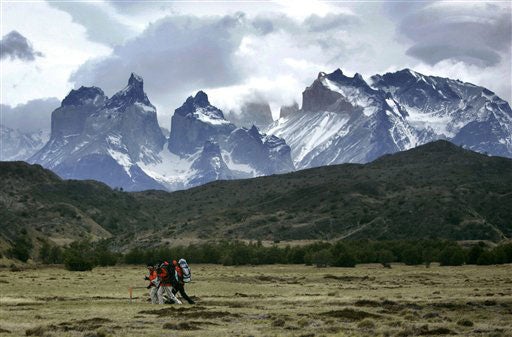Chile: Gone with the guanacos
The Paine River drops spectacularly between Lakes Nordenskjold and Pehoé, treating awed onlookers to multiple rainbows on a sunny day

Your support helps us to tell the story
From reproductive rights to climate change to Big Tech, The Independent is on the ground when the story is developing. Whether it's investigating the financials of Elon Musk's pro-Trump PAC or producing our latest documentary, 'The A Word', which shines a light on the American women fighting for reproductive rights, we know how important it is to parse out the facts from the messaging.
At such a critical moment in US history, we need reporters on the ground. Your donation allows us to keep sending journalists to speak to both sides of the story.
The Independent is trusted by Americans across the entire political spectrum. And unlike many other quality news outlets, we choose not to lock Americans out of our reporting and analysis with paywalls. We believe quality journalism should be available to everyone, paid for by those who can afford it.
Your support makes all the difference.Rare are the days I've clambered out of bed, finished breakfast and within minutes found myself surrounded by sedately munching guanacos, frolicking grey fox cubs and mighty condors soaring over lofty peaks. Torres del Paine National Park, in Chilean Patagonia, proved to be the place for just such exceptional experiences.
The view from my window at the Tierra Patagonia hotel, overlooking Lake Sarmiento, was enough to inspire even the laziest soul to get out of bed. For an overview of the park's mountains, lakes, rivers and glaciers, I'd signed up for a full-day tour, but even that was only scratching the surface. A thorough look would require at least a week and some sturdy boots.
The minibus curved along a gravel road around Lake Sarmiento towards the east entrance. All along the roadside, guanacos were grazing contentedly. Our first stop inside the park was the Nordenskjold viewpoint, overlooking the lake of the same name. It was named after Swedish geologist and explorer Otto Nordenskjold who, not content with all the lakes in Scandinavia, had gone off to discover this one at the turn of the 20th century, after leading the Swedish Antarctic expedition. His lake sits at the foot of Cuernos del Paine at 2,600m, with the Torres del Paine massif towering behind.
From here it's a short drive to the Salto Grande waterfall. Here, the Paine River drops spectacularly between Lakes Nordenskjold and Pehoé, treating awed onlookers to multiple rainbows on a sunny day. At Salto Grande you can also view Paine Grande, the park's highest mountain at 2,884m.
Maybe it was all that fresh air, or watching those guanacos munching away, but I was getting peckish – happily just in time for a picnic lunch. By Lake Toro, near the southern fringes of the park, the guide was dishing up a feast of cold beef, pies, local cheeses, breads and refreshing Chilean wines.
After a morning of mountains, lakes and rivers, there was one key element left to see – glaciers. Part of the Southern Patagonian ice fields, the park has more than a few, but Glacier Grey is the easiest to view. As I walked along the shores of Lake Grey in the afternoon sunshine, the glacier came into view behind me, seemingly lapping at the lake with its long, grey tongue. All was peaceful and pristine, but something was missing. Glacier Grey, although magnificently majestic, offered nothing to nibble – consequently, the guanacos were gone.
Footprint's new Chile Handbook is priced £14.99 (footprinttravelguides.com)
Join our commenting forum
Join thought-provoking conversations, follow other Independent readers and see their replies
Comments